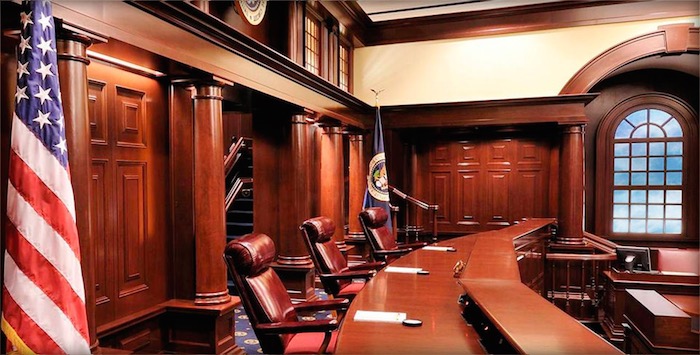“While extrinsic evidence may sometimes illuminate a well-understood technical meaning, … that does not mean that litigants can introduce ambiguity in a way that disregards language usage in the patent itself.” – Federal Circuit
 The United States Court of Appeals for the Federal Circuit (CAFC) on Tuesday affirmed an invalidity decision of the U.S. Patent and Trademark Office’s Patent Trial and Appeal Board (PTAB) in Immunex Corporation v. Sanofi-Aventis U.S. LLC. Considering the intrinsic and extrinsic evidence, the CAFC agreed with the PTAB’s construction of the disputed claim term, “human antibodies,” and affirmed the holding that the patent in suit was invalid as obvious.
The United States Court of Appeals for the Federal Circuit (CAFC) on Tuesday affirmed an invalidity decision of the U.S. Patent and Trademark Office’s Patent Trial and Appeal Board (PTAB) in Immunex Corporation v. Sanofi-Aventis U.S. LLC. Considering the intrinsic and extrinsic evidence, the CAFC agreed with the PTAB’s construction of the disputed claim term, “human antibodies,” and affirmed the holding that the patent in suit was invalid as obvious.
U.S. Patent No. 8,679,487 (the ’487 patent), owned by Immunex Corp. (Immunex), was directed to “antibodies that bind to the human interleukin-4 (IL-4) receptor, the resulting inhibition of which is significant for treating various inflammatory disorders, such as arthritis, dermatitis, and asthma.” Sanofi-Aventis U.S. LLC, Genzyme Corp., and Regeneron Pharmaceuticals, Inc. (collectively, Sanofi) challenged the ’487 patent in an inter partes review proceedings (IPRs) and the PTAB invalidated all challenged claims in one of the IPRs. In particular, the PTAB concluded that the claims were invalid over two prior art references, which turned on the finding that the term “humanized” antibody met the construction of the claim term “human antibody.” Immunex appealed to the CAFC, arguing that the PTAB misconstrued the claim term.
Claim Construction Standard
On appeal, the CAFC initially considered the applicable claim construction standard. Noting that that the PTAB applies the Phillips district-court claim construction standard in all newly filed IPRs, the CAFC explained that, at the time Sanofi filed the IPRs, the PTAB applied the broadest reasonable interpretation (BRI) standard to unexpired patents. Thus, the CAFC noted that the PTAB’s claim construction was to be reviewed using BRI standard.
On appeal, Immunex challenged the PTAB’s determination that the BRI of “human antibody” “includes both fully human and partially human antibodies.” Immunex argued that “humanized” is not “human.” The CAFC reviewed the PTAB’s construction de novo.
Review of the Intrinsic Record
In considering the intrinsic record for claim construction purposes, the CAFC initially looked to the language of the claim itself and noted that nothing in the claim’s language restricted the term “human antibodies” to only those that are fully human. The CAFC also consider the patent specification, which contrasted “partially human” with the terms “fully” or “completely human” and made clear that the term “’human antibodies’ [was] a broad category encompassing both partially and completely human antibodies.” Thus, the CAFC noted that the specification confirmed a BRI of “human antibodies” to include those that are “partially human,” “including ‘humanized’ antibodies.”
The CAFC also reviewed the prosecution history in its analysis of the intrinsic record. Noting that prosecution of related patents can be relevant to claim construction, the CAFC explained that Immunex used both of the terms “fully human” and “human” within the same claim set in another patent application in the same patent family as the ‘487 patent. The CAFC found that there was no convincing explanation for the simultaneous use of the two terms except for the conclusion that they are not interchangeable.
Quoting Nobel Biocare Servs. AG v. Instradent USA, Inc., CAFC stated that “there is a strong presumption against a claim construction that excludes a disclosed embodiment.” The CAFC noted above that the specification’s embodiments include both humanized and chimeric partially human antibodies, which illustrated why the presumption against their exclusion from the claims was not overcome. Thus, the CAFC concluded that the prosecution history also supported the Board’s construction of “human antibodies.”
Extrinsic Evidence
The CAFC then considered the extrinsic evidence with respect to the Board’s claim construction, noting that “[w]hile extrinsic evidence may sometimes illuminate a well-understood technical meaning, … that does not mean that litigants can introduce ambiguity in a way that disregards language usage in the patent itself.” The CAFC explained that, while Immunex presented extrinsic evidence including expert testimony, the CAFC did not find anything “credible to call its interpretation into question.” Thus, the CAFC concluded that the intrinsic evidence in this case decided the issue and, thus, “the intrinsic record trumps.”
Prior Inconsistent Claim Interpretation
In a litigation that prompted the IPR a district court construed “human” to mean “fully human” only. During the IPR proceeding, the PTAB did not adopt the district court’s construction. Rather, the PTAB reached a different interpretation of the claim term “based on the broader applicable case law.” Citing Power Integrations, Inc. v. Lee, the CAFC explained that the PTAB “is not generally bound by a previous judicial construction of a claim term.” The CAFC acknowledged that the PTAB was required to provide “reasoning in sufficient detail to permit meaningful appellate review,” and noted that the PTAB’s reasoning for not adopting the district court’s claim construction was sufficiently detailed to permit meaningful appellate review. Thus, the CAFC affirmed the Board’s judgment holding the ’487 patent invalid as obvious.

![[IPWatchdog Logo]](https://ipwatchdog.com/wp-content/themes/IPWatchdog%20-%202023/assets/images/temp/logo-small@2x.png)

![[Advertisement]](https://ipwatchdog.com/wp-content/uploads/2024/05/Quartz-IP-May-9-2024-sidebar-700x500-1.jpg)
![[Advertisement]](https://ipwatchdog.com/wp-content/uploads/2024/04/Patent-Litigation-Masters-2024-sidebar-last-chance-700x500-1.jpg)

![[Advertisement]](https://ipwatchdog.com/wp-content/uploads/2021/12/WEBINAR-336-x-280-px.png)
![[Advertisement]](https://ipwatchdog.com/wp-content/uploads/2021/12/2021-Patent-Practice-on-Demand-recorded-Feb-2021-336-x-280.jpg)
![[Advertisement]](https://ipwatchdog.com/wp-content/uploads/2021/12/Ad-4-The-Invent-Patent-System™.png)






Join the Discussion
No comments yet.